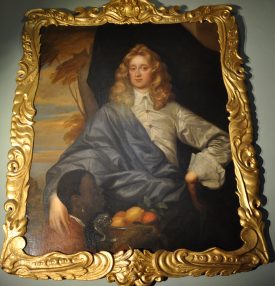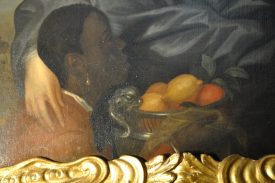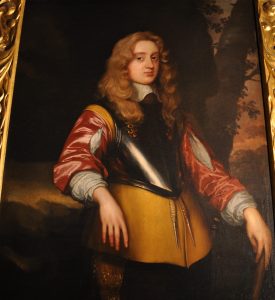Like oranges, black servants were far from uncommon in wealthy households during the 1600s. Indeed, both King Henry VIII and his daughter Elizabeth I had black people employed within their households. A court roll dated to 1511 shows King Henry’s black trumpeter John Blanke riding on horseback amongst other finely dressed pages. This portrait certainly follows the 17th century fashion for showing wealthy aristocrats depicted in their finest clothing, alongside their equally exotic black attendants.
Van Dyck’s influence
Van Dyck, the Flemish painter who set the tone for British portraiture from 1630s onwards, was known for painting some his British patrons with their black servants. Italian painters such as Titian and Veronese, Venetians whom Van Dyck admired immensely, set the trend for this type of portrait a century earlier. Although Van Dyck’s influence is clearly felt in this painting it is very likely that this image depicts an actual servant who worked in the Greville household during the mid 1600s. The combination of these rare citrus fruits with a black servant captures the exoticism, wealth, worldliness and ambition of the family. Perhaps one day the Greville archives and account books of this period might reveal further details of the identity of this young man.
We know that the Grevilles owned plantations and slaves in Tobago later in the 18th century. Several surviving documents relating to a mortgage on the plantations made in 1770-1 actually list the name of the slaves owned by the 1st and 2nd Earls.1 Their names, including the likes of Titus Nero, Cesar, Hercules, Daphne, Diana and Venus, follows the contemporary fashion for naming black servants and slaves after figures from the classical world. These documents make for incredibly hard reading, especially as we consider that these human beings were traded and treated like commodities. Auspiciously, Henry Richard Greville (1779-1853), 3rd Earl of Warwick, was later listed as ‘friendly’ to the eventual abolition of the slave trade at the beginning of the 19th century.
Which Greville?
Returning to the portraits, which Greville might this flamboyant white shirted man be? The painting is currently tentatively identified as Robert, 2nd Baron, who was killed during the siege of Lichfield in 1643. We know that Robert was interested in colonial expansion, as he founded the new town of Saybrook in Connecticut with Lord Saye in 1635. Stylistically, it is unlikely that either of the two paintings were made when Robert, 2nd Baron, was alive.2 Could the swath of black drapery hanging behind his head indicate that it was painted posthumously?
Alternatively, are these both images of the same son or different sons of Robert? The first reference we have of the painting was made by paintings connoiseur George Vertue in 1730, which he described the picture as ’Francis Ld Brooke with a Blackmore – Soest’.3 Gilbert Soest, to whom this portrait can be loosely attributed to, was a Dutch born painter whose first recorded painting in England dates to 1646. Francis was rather sickly according to surviving medical accounts. The famous Dr. James Cooke of Warwick dedicated his celebrated medical text Mellificium Chirurgae (1648) to his patron and patient Francis, Lord Brooke. Although it may be tempting to read the malformed hands and wrist in the portrait as evidence for physical deformity, these features are more likely to be due to the weakness of the painter rather than an accurate representation of the sitter.
These paintings are jewels of exotic flavour, scent, and colour, waiting in corridors ready to be rediscovered and enjoyed.
(I will be discussing the Gardens of Sir Fulke Greville in a lecture for the Alcester Local & District History Society on Wednesday 11th January 2017 – see events page.)
References
1 Warwickshire County Record Office reference CR1886/BB825/Boxes 446-8
2 The portrait of the man in armour has traditionally identified as Francis, and is attributed to artist John Hayls. The inclusion of armour in this picture is most intriguing, as it was Robert not Francis who was the solider.
3 Vertue Note-books, Walpole Society (1935-36) 4:24, p. 63










Comments
Add a comment about this page